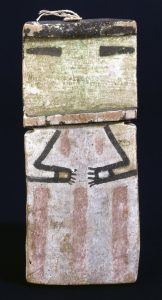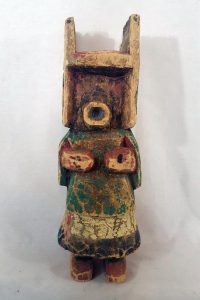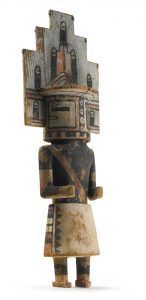Kachina dolls are figures carved, typically from cottonwood root, by Hopi people to instruct young girls and new brides about katsinas or katsinam, the immortal beings that bring rain, control other aspects of the natural world and society, and act as messengers between humans and the spirit world.
Except for major ceremonial figures, most katsina figures originated in the late 19th century. The oldest known surviving figure dates back from the 18th century—it was a flat object with an almost indistinguishable shape that suggested a head and contained minimal body paint. Kachina dolls are generally separated into four stylistic periods: the Early Traditional, Late Traditional, Early Action, and Late Action periods.
Every symbol, color, and design on a Hopi kachina figure has definite meaning in connection with Hopi religion, custom, history, and way of life. Animal tracks, bird tracks, celestial symbols, and vegetable symbols represent those particular spirits. Other symbols and their meanings are as follows:
A pair of vertical lines under the eyes symbolizes a warrior’s footprints.
An inverted “V” signifies certain kachina officials.
Phallic symbols represent fertility.
Certain colors on the kachina figures also have significant directional meanings:
Yellow = north or northwest
Blue-green = west or southwest
Red = south or southeast
White = east or northeast
All the colors together = Zenith (heaven) and above
Black = Nadir (the underworld) or down
Reference Wikipedia





